Have you ever dreamed of setting up a freshwater tank with a lobster?
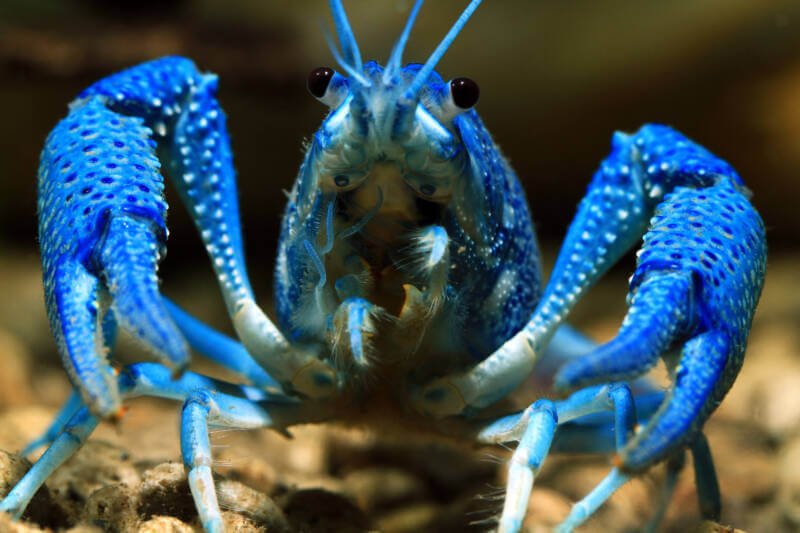
Well, there’s no such thing as a freshwater lobster, but the electric blue crayfish (Procambarus alleni) comes close in appearance.
And with that vibrant sapphire color, who could resist?
Crayfish share several characteristics with lobsters, and they come from the same families – Astacidae in the Northern hemisphere and Parastacidae and Austroastracidae in the Southern hemisphere.
However, no other species lacks the gene that turns the exoskeleton cobalt blue.
Florida crayfish is included on the IUCN Red List as a species of Least Concern.
While sturdy aquarium inhabitants and colorful additions many aquarists crave, you’re better off skipping these feisty invertebrates until you’ve gained experience.
Blue crayfish require peak water quality to remain healthy, not to mention some invertebrate know-how.
At a Glance
| Min tank size: | 30 gal (120 l) |
| Temp: | 65-75°F (18-24°C) |
| Avg. lifespan: | 5-6 years |
| Adult size: | 4-6 inches (10-15 cm) |
| School size: | alone, ideally |
| pH: | 6.5-7.5 |
| Behavior: | peaceful and active |
| Hardness: | 3-10 dH |
| TDS: | 150-200 |
| Ammonia, nitrite and nitrate: | 0 ppm |
In this article
In the Wild
Electric blue crayfish have earned the distinction as Florida’s only native crayfish species.
They inhabit waters east of the St. John’s River, south of Marion and Levy counties, and even as far down as the Florida Keys.
Blue crayfish prefer slow-moving waterways, including streams, ditches, marshes, floodplains, and wetlands.
During periods of drought, crays burrow deep into the mud, using every drop of moisture to survive.
While strictly freshwater species, blue crayfish CAN survive in brackish water.
These hardy invertebrates have tolerated salinity levels up to 18 ppt without a problem. However, given the option, they prefer freshwater.
Aquarists prize that stunning sapphire color, but you’ll find other varieties in the wild.
Though not as flashy, the species comes in red, orange, brown, and white. All of the crays feature a lighter speckling.
Size: Hold the Butter

Blue crayfish may resemble miniature lobsters, but they wouldn’t impress on anyone’s dinner plate.
Compared to their larger oceanic cousins, they come up short. Once adults, they top out around 4-6 inches (10-15 cm) in length.
It’s important to remember that crayfish molt throughout their lives.
The process slows down once the cray reaches maturity, but you’ll see molting frequently during their early months.
A rough schedule to keep in mind:
- Babies: Every few days
- Juveniles: Every 1-3 weeks
- Adults: Every 4-8 weeks.
Lifespan
Electric blue crayfish live an average of 5-6 years. Unfortunately, this requires you to stay on top of pristine water quality.
Crays often succumb to ammonia poisoning, which reduces their lifespan. You need to remain committed to water changes and testing.
Behavior
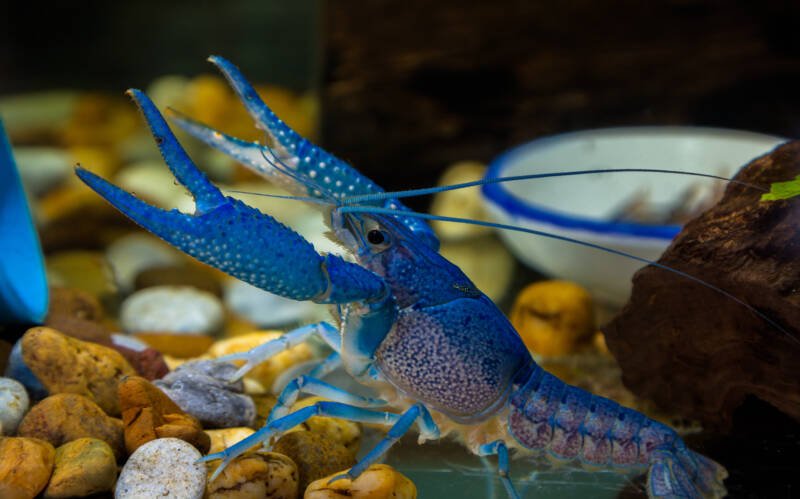
As you might guess from their appearance, blue crayfish don’t have the most peaceful temperaments.
They’ll attempt to grab any living creature that happens to come within reach, especially if they feel that creature’s invading their territory.
Most aquarists make do with a single electric blue crayfish in their tank.
Managing that tiny invertebrate brain’s attempts to sneak up on fish is more than enough to handle. Especially as crays aren’t content to stay along the bottom – they CLIMB!
If you consider keeping more than one at a time, make sure you supply enough space. Everyone needs plenty of territory to minimize aggression and fighting.
You also want to provide an adequate food supply. Nothing starts squabbles more than empty stomachs!
If you know, you’re going to want a tank with more than one crayfish, purchase everyone right away.
Introducing a new cray into an established aquarium will prompt attacks on the new arrival. You need everyone to start together to prevent problems.
Tank Setup
For the best chance of success, you should stick to a minimum tank size of 30 gallons (114 l).
You’ll allow for space for exploration, development of territory, and management of your water quality.
NEVER go smaller – you’ll only create problems.
Always find a quality lid to match your tank. Remember, crayfish climb! They won’t have the strength to lift a cover but expect your blue crayfish to set out on explorations if there isn’t one in place.
Those impressive claws present additional tank concerns. Sponge filters won’t hold up to abuse if your cray snips at the material.
You’re better off with an HOB or canister filter. You want the right blend of filtration (crays create A LOT of waste) and sturdiness.
And while crays prefer sluggish water, invest in an air pump or an air stone. Electric blue crayfish need adequate oxygen content in their tank. Otherwise, they’ll drown.
If you don’t want to add an air pump, provide a rock so they can climb out of the water.
Water Conditions
Florida waters range from tropical to sub-tropical, depending on the season.
Your blue crays would like an ideal temperature of 70°F (21°C), but anything between 65-75°F (18-24°C) will work out for them.
You want relatively neutral, soft waters. A pH range of 6.5-7.5 and a hardness between 3-10 dH works best.
This is because you need to keep an eye on your total dissolved solids (TDS).
TDS include EVERYTHING dissolved in the water you’re using.
TDS matters for invertebrates for proper health. If your tap water contains too many minerals, you need to consider using a dechlorinator to bring the TDS down to the 150-200 range. Or you can use distilled water as an alternative.
Blue crayfish HATE unclean water. You need to keep the ammonia, nitrites, and nitrates as close to 0 ppm as humanly possible.
NEVER add crays to a tank that hasn’t gone through a proper nitrogen cycle!
Decorating the Electric Blue Crayfish Tank
The cobalt color that makes blue crayfish so popular stands out best against blue substrates, oddly enough.
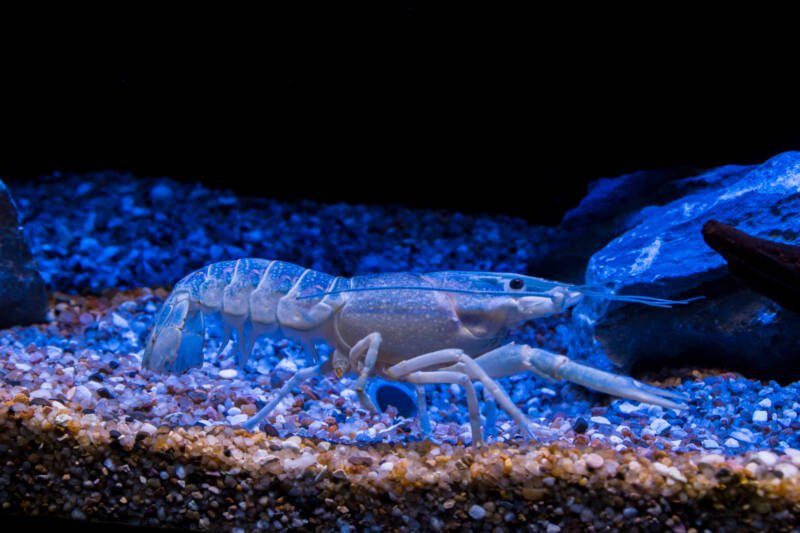
You can use colored gravel or sand. If you opt for sand, you’ll give your crays a chance to burrow into the bottom.
The biggest décor requirement for crays is hiding places.
Blue crayfish must molt their exoskeleton to grow, but they’re incredibly vulnerable during the process. They need somewhere secure to hide out.
Choose driftwood, artificial caves, PVC tubes, or overturned pots to give your blue crayfish somewhere to molt in peace.

Ensure the cave’s large enough for them to fit inside comfortably, without getting disturbed by tank mates.
You also want to mimic their native habitat by providing live plants. The greenery will help you maintain that nitrogen cycle, too.
Unhappily, electric blue crayfish can be hard on plant life.
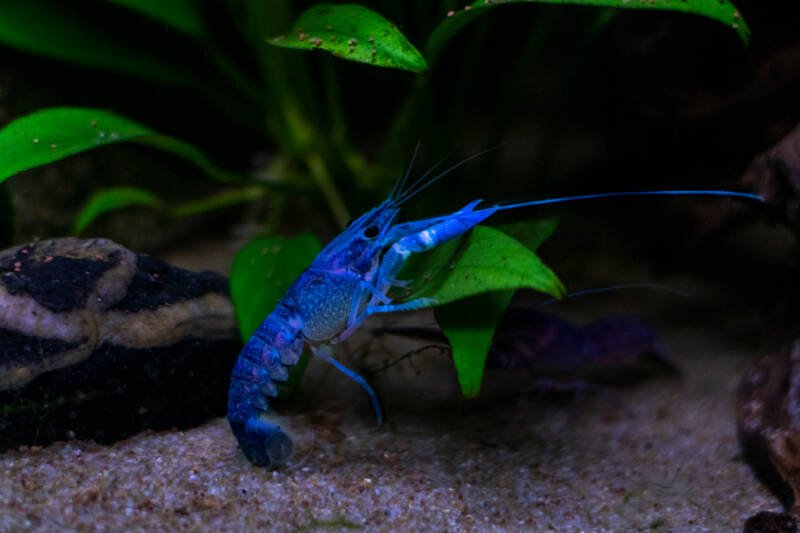
If you want crayfish-safe plants, choose floating types. Otherwise, the following plants rank high on blue crayfish favorite lists:
- Anacharis
- Hornwort
- Java fern
- Marimo moss.
Electric Blue Crayfish in Communities
Electric blue crayfish may not play nicely with others, but that doesn’t mean you have to house them alone.
If you’re careful with your choices of tank mates, they do well in community aquariums. Just keep in mind that climbing ability.
Tank Mates
While blue crayfish have no problem taking swipes at whoever swims by, they’re not particularly fast.
So if you choose to add fish to the tank with top swimming speeds, you shouldn’t have a problem.
Aiming for the middle and top of the aquarium will also help. Top choices include:
- Danios (zebra, celestial pearl)
- Hatchetfish
- Rainbow darters
- African butterflyfish
- Rasboras
- Rainbow sharks
- Tiger barbs
- Rosy red minnows
- Redtail sharks
- Guppies
- Pearl gouramis.
Incompatible Species
You want to skip large, aggressive fish, which might view your crays as a potential menu option. This means no cichlids (especially the bigger South American cichlids).
Crays may sport claws, but they don’t hold up well against predators.
Freshwater shrimp and snails need to stay out of your community, too.
Blue crayfish are opportunistic, and they won’t be able to resist helping themselves to any other invertebrates you add to the tank.
Diet and Feeding
Electric blue crayfish scavenge in the wild, selecting a little bit of everything.
This makes them simple to feed, but you want to make sure you offer a high-quality and well-balanced diet so they stay healthy and molt without any issues.
A base commercial diet works well, and your crays will eat it without a problem.
Once a day, no more than they can consume in a few minutes is plenty. You don’t want to create excess waste.
Popular cray commercial diets include:
- Algae wafers
- Sinking pellets
- Spirulina flakes.
An occasional treat of protein works well, too. You can choose from frozen, freeze-dried, or live options.
Make sure any live protein you add to the tank is slow enough for your crays to catch, though:
- Blackworms
- Bloodworms
- Crab pellets
- Dwarf shrimp tails.
And, of course, don’t skip the vegetables. Blanched and peeled veggies always top blue crayfish lists in popularity.
Plus, they’ll keep your crays from destroying the tank greenery:
- Carrots
- Cucumber
- Lettuce
- Peas
- Potato (use sparingly)
- Spinach
- Zucchini.
Finally, you HAVE to provide a quality calcium source. Blue crayfish require calcium to maintain the strength of their shell.
They DO consume their molt, but they need calcium prior to that. Cuttlebones and eggshells might work well.
Breeding: Piece of Shrimp Cake
If you have a male and female blue crayfish, odds are you’ll end up with baby crays.
Getting those young to survive to adulthood is the trickier part of the equation. To boost your success, set up a separate tank to house the young.
Males or Females?
If you flip your electric blue crayfish over, you’ll notice claspers behind the legs on the male and sperm receptacles behind the legs on the female.
However, most aquarists don’t make a habit of turning their crays over.
Luckily, you can tell the two apart from the top. Males have MUCH larger claws than females.
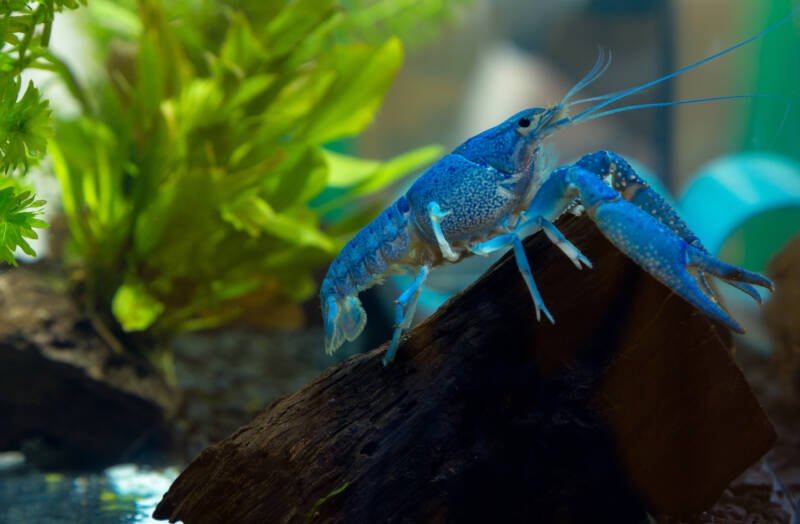
The tail is also longer, narrower, and straighter when extended. Females, meanwhile, have shorter tails that curl slightly.
Hormone Timing
Remember that blue crayfish don’t get along? That extends to the mating process.
The male climbs onto the female’s back and grips her with the claspers and claws.
However, immediately following the mating, the two get aggressive and may need you to intervene.
If you separate the pair into another tank, this will go easier for you. Males pass a sack of sperm to the female. She’ll lay her eggs, passing them through the sperm for fertilization.
Go ahead and return the male to the community tank unless the pair’s breeding tank is large enough.
The female carries the eggs under her tail for around one month. After they hatch, she releases hormones that encourage the babies to stay close for her to care for them.
However, that hormone stops after three days, and then she needs to leave, or she’ll eat them.
You’ll need to take over at that point if you want to raise healthy baby crays. They eat spirulina, baby brine shrimp, and crushed pellets.
And don’t fret over time – with the frequent molting, they’ll grow and be ready for a community in no time.
Health and Disease
When exposed to ammonia or nitrates, electric blue crayfish become stressed.
As stress levels increase, their immunity levels decrease. They then become susceptible to disease, passing away well before their time.
Crays require weekly water changes of 25%. You’ll keep your water quality at a higher level.
Stocking your tank with live plants will also help, though you’ll face the risk of your crays eating or destroying the greenery.
Wild-caught blue crayfish may introduce crayfish plague to your aquarium.
This mold attacks invertebrates, growing in the cray’s soft parts and invading the nerve cord and brain. You’ll see a progression of poor coordination as the infestation worsens.
Electric Blue Crayfish: Are They for You?
In general, electric blue crayfish run around $40. You may see the price fluctuate based on the season, especially if you’re purchasing a wild-caught cray.
They’re not the most expensive invertebrate to add to your aquarium, but they aren’t the cheapest, either.
You’ll find people shocked that the vibrant cobalt color is real. It seems like the result of a lens, filters, or image manipulation.
So if you’re looking for the perfect addition to your colorful freshwater aquarium, you couldn’t ask for a better option.
However, they have a nasty streak that puts slower fish at risk of becoming a snack.
You also have to consider special needs if you want to keep more than one.
And don’t forget those water conditions. It’s a careful balance and one that’s not intended for novice aquarists.
Not Photoshopped
With a stunning shade of sapphire on a mini lobster body, electric blue crayfish attract aquarists worldwide.
They’re hardy, but they come packed with management demands.
You need to make sure you’re prepared to meet water excellence before you take on these gorgeous crays.
Have you kept blue crayfish? Has one ever escaped from your tank?
How do you handle your breeding situation?
Let us know your questions and stories here!